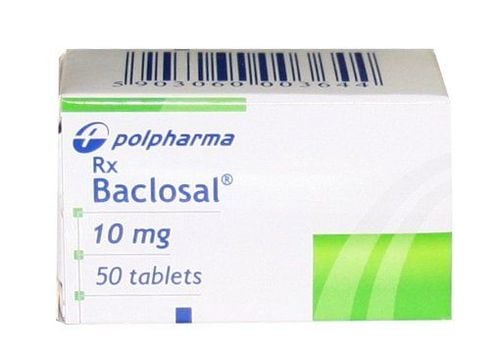This is an automatically translated article.
Zanaflex is a short-acting muscle relaxant that is most effective 1 to 6 hours after use. The drug is mainly used in daily activities that need to support relaxation and reduce muscle spasms.1. What does Zanaflex do?
What is Zanaflex? Zanaflex (also known as Tizanidine), is a short-acting muscle relaxant that works by blocking nerve impulses (the sensation of pain) from being sent to the brain.Zanaflex is often used to treat spasticity in conditions such as multiple sclerosis, spinal cord injury, ... by temporarily relaxing muscles. In addition, Zanaflex may also be used for other purposes not specifically listed in this medication guide.
2. Instructions on how to use Zanaflex
Suggested usual dose for adults with muscle spasms:Initial dose: Take 2mg every 6 - 8 hours (your doctor may consider increasing your dose if needed); Zanaflex can be taken up to 3 times a day if needed. However, the interval between doses should be 6-8 hours. Do not take more than 16mg of Zanaflex at one time. Absolutely do not take more than 3 doses (36mg) in 24 hours because it can damage the liver. You may need frequent blood tests to check your liver function; Zanaflex can be taken with or without food, but it is important to maintain the same oral regimen each time. Zanaflex capsules and tablets are absorbed differently by the body. Switching between tablets and capsules may cause changes in side effects or affect how well the medicine works; Zanaflex is a short-acting muscle relaxant and its effectiveness peaks 1-2 hours after administration and lasts for 3-6 hours. Patients should take this medication only for daily activities that require relief from muscle spasms. If you have been using Zanaflex for a long time and then suddenly stop taking it, you may experience withdrawal symptoms such as: Dizziness, heart palpitations, tremors and palpitations. Talk to your doctor about how to safely stop taking your medication.
3. Side effects of the drug Zanaflex
During treatment, users may experience some side effects of Zanaflex such as:Less serious side effects:
Dizziness, drowsiness; Feeling anxious or stressed; Numbness or itching; Sweating, skin rash; Stomach pain; Diarrhea ; Constipation, vomiting; Fever; Dry mouth ; Back pain, muscle weakness; Increased muscle tone, spasms. More serious side effects: Get emergency medical help if you have any of these signs:
Difficulty breathing, allergies, swelling of the face - lips - tongue - throat; lightheadedness, fainting, slow heart rate; Hallucinations, confusion, unusual thoughts or behavior; Abdominal pain, nausea, low-grade fever, loss of appetite, dark urine, clay-colored stools, yellowing of the eyes or skin; Burning or painful urination. Zanaflex may cause side effects that may impair thinking or reactions. Therefore, users should be careful when driving or doing any task that requires alertness and vigilance. Dizziness may increase when moving from a sitting or lying position. Get up slowly to reduce the risk of stumbling and falling.
4. Notes when using Zanaflex
When you are planning to take Zanaflex, you should tell your doctor if you are allergic to any of its ingredients, or if you have:Liver disease; Kidney disease; Low blood pressure; High Blood Pressure ; Have a history of long QT syndrome. These factors may prevent you from taking Zanaflex , or you may need to adjust your dose or perform special tests during treatment.
Other notes:
This is a short-acting drug, so it is only used for daily activities that need to reduce muscle spasms; Zanaflex should not be taken if you are also taking the antidepressant Fluvoxamine (Luvox) or the antibiotic Ciprofloxacin (Cipro); Do not take Zanaflex at a time when you need to keep your muscles strong for balance and safe movement in certain activities. In some situations, the lack of muscle tone can jeopardize physical safety; Do not take more than 3 doses (36mg) of Zanaflex in 24 hours because taking too much of it can damage the liver; The drowsy effect caused by Zanaflex may be increased if used concurrently with cold medicines, sleeping pills, allergy medicines, narcotic pain relievers, other muscle relaxants and medicines for convulsions, depression and concerned. So tell your doctor if you need to take any other medicines with Zanaflex; Avoid drinking alcohol during drug treatment as it may increase some of the side effects of Zanaflex.
5. Zanaflex drug interactions
Before taking Zanaflex, tell your doctor if you are using any of the following medicines:Acyclovir (Zovirax); Cimetidine (Tagamet); Famotidine (Pepcid); Ticlopidine (Ticlid); Zileuton (Zyflo); Birth control pills; an antibiotic such as Gatifloxacin (Tequin), Enoxacin (Penetrex), Levofloxacin (levaquin), Moxifloxacin (Avelox), Sparfloxacin (Zagam), Lomefloxacin (Maxaquin), Trovafloxacin (Trovan), Ofloxacin (Floxin), or Norfloxacin (Noroxin); blood pressure medication such as Clonidine (Catapres), Guanfacine (Tenex), Guanabenz (Wytensin), or Methyldopa (Aldomet); Heart rhythm medications such as Amiodarone (Cordarone, Pacerone), Mexiletine (Mexitil), propafenone (Rythmol), and Verapamil (Calan, Isoptin, Covera). There are also other medicines not listed that may affect how Zanaflex works. To be more proactive, users should inform their doctor about all prescriptions and OTC drugs they are taking (including vitamins, minerals, herbs and drugs prescribed by other doctors). Do not take a new medication on your own without telling your doctor.
It is not known whether Zanaflex will harm an unborn baby, so it is still best to tell your doctor if you are pregnant or plan to become pregnant. Zanaflex may also affect breast milk, so breast-feeding is not recommended while taking this medicine. For older people, Zanaflex may take longer to be eliminated from the body. Users should strictly follow the instructions of the doctor on the specific use and dose.
Please dial HOTLINE for more information or register for an appointment HERE. Download MyVinmec app to make appointments faster and to manage your bookings easily.













